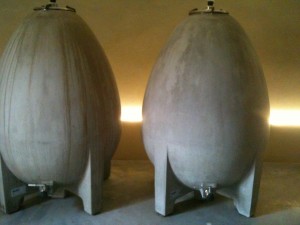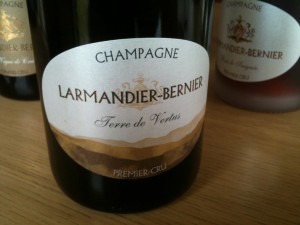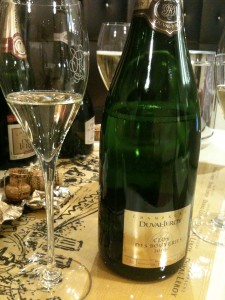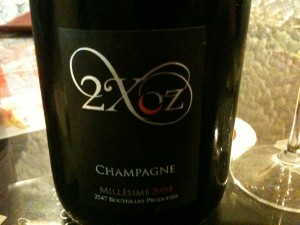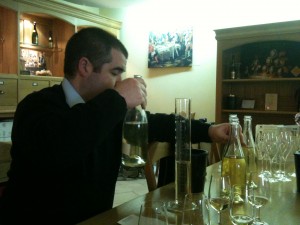A few months ago I moved to Champagne to write more whilst specializing in this wonderful wine:-). As I am discovering my new playing ground I seem to stumble upon so many true gems, unusual wines and fabulous producers which I would like to share in the “Caroline’s Champagne” section of my blog.
Originally I had thought to start with Zero Dosage Champagnes as I have a real soft spot for this “naked” style of sparkling wine. However since the article I wrote on this topic for Palate Press has just been published , I decided instead to launch “Caroline’s Champagne” by talking about some great single vineyard Champagnes I have tried last week.
Single vineyard Champagne is a bit of an anomaly – as blending or “assemblage” is king here in Champagne. It was at the origin of Champagne – Dom Perignon’s real claim to fame is the fact that he started to blend different varieties, plots and later vintages to make a consistent quality wine. And today the bulk of the Champagne produced, especially by the large Champagne Houses, is still a blend of different terroirs, grapes and vintages. Lots of producers and people I have spoken to since arriving here tell me that the blend across the different vineyards and subregions is what makes Champagne great…
However on the fringe, there are some really exciting single vineyard projects happening :-)
Because Champagne is a marginal wine growing region with multiple soil compositions and lots of micro-climates I do believe that you really have to understand your vineyard, the soil, micro-climate, and invest in separate parcel vinification to correctly pinpoint which plots will shine by themselves. So it is not really surprising that the single vineyard projects are generally led by the Vigneron Indépendant or Récoltant-Manipulant rather than the big houses. And the more single vineyard Champagnes I taste, the more I believe that it is here that the Vigneron Indépendant can truly shine without having to compete with the Negotiants.
Champagne Larmandier-Bernier Terre de Vertus 2007 Brut Zero: 100% Chardonnay, a Zero Dosage Champagne aged for 4 years on the lees. Light golden in colour with fine bubbles. Fresh Macadamia, quince and red apple on the nose, with flavours of ripe pear, red apple, fresh almonds and macadamia and a very mineral, chalky finish with a few saline notes.
Champagne Larmandier-Bernier Vieilles Vignes de Cramant Extra Brut 2006: A single vineyard Champagne made from 100% Chardonnay from vines of 50 to 70 years old, 2g/l dosage. Golden colour with very fine bubbles. Intense and voluptuous nose with aromas of ripe apple, white nectarine and a little hint of vanilla. Flavours of stewed ripe apple, quince paste, great minerality and little flintiness in the lingering finish.
Champagne Larmandier-Bernier Vieilles Vignes de Cramant Extra Brut 2005: Exactly the same wine from the 2005 vintage and it is mind blowing how different the expression of the terroir is between the 2 vintages. Wet chalk and earthy notes on the nose, elegant mineral driven wine, with hints of quince, pear and a little meyer lemon and fresh Macadamia, lots of mineral notes (flint, chalk, river stone) in the lingering finish.
Champagne Larmandier-Bernier Rosé de Saignée NV: 100% Pinot Noir. Grapes are destemmed and left to macerate for two days before being pressed off. Deep Pink in colour with fine bubbles. A real Pinot nose with aromas of wild strawberry, ripe raspberry and some hints of mushroom and earth. Medium bodied wine with flavours of red berries and a lingering earthy almost smokey finish. Perfect match for a charcuterie platter!
A few days later I came across another excellent single vineyard Champagne – Clos des Bouveries 2005 by Duval-Leroy. Duval Leroy is a large independently owned Champagne House. The production today is about 5 million bottles and the Owner/CEO, Carol Duval-Leroy as well as the cellar master, Sandrine Logette-Jardin are women which is pretty unique in Champagne.
Champagne Duval-Leroy Clos de Bouveries 2005: 100% Chardonnay. Pale golden in colour with small bubbles. An elegant mineral nose with aromas of apple blossom and white flowers. Crisp Champagne, with flavours of red apple, almond pastry and mineral chalky and flinty notes in the long finish.
I had a blitz visit to Champagne Pouillon and was totally blown away by Elodie and Fabrice Pouillon’s 2XOZ 2004. I had briefly tasted this wine on Champagne Day in Reims last year and remembered liking it but I had forgotten just how amazing and complex this Champagne was. 2004 was the first vintage of the 2XOZ. The wine is made from 100% Pinot Noir harvested from part of the Ecueil vineyard in Mareuil-sur-Ay. The vines are on average is 47years old and the Champagne is made in a artisanal way. The fruit is picked at about 12.5% alcohol, which is significantly higher than usual in Champagne. Only natural yeasts are used, which for the second fermentation come from the lees of the first fermentation, and concentrated must is added instead of sugar to the liqueur de tirage and liqueur de dosage. The wine was aged for 7 years and only 2547 bottles have been produced.
On Tuesday Morning I once again visited Tarlant as they do some FABULOUS single vineyard wines. I described most of them in my post on Tarlant but want to briefly mention here a little newish project of Benoit Tarlant. About 7 years ago he planted a small plot with 5 rows of each of 3 of the lesser known Champagne varieties, Pinot Blanc, Arbanne and Petit Melier. He’s trying to understand their specific characteristics and behaviour in the vineyard as well as in the winery where he has been experimenting with a “BAM” Cuvee.
I will continue to search out and share different single vineyard cuvée’s and other unusual blends with a focus on independent growers. Besides the element of excitement they add, I feel they are within price reach of Champagne and wine lovers who are looking for something cutting edge and a little more unique. And they prove that terroir is important and can be expressed also in a sparkling wine:-)
I would like to finish off by saying that besides Duval-Leroy, a few other Champagne houses make a single vineyard cuvée. However as single vineyard means low volume these wines have generally become a super Cuvée Prestige for the House: they are very sought after hence quite expensive. Please find a few examples here below. I took the average pricing from Winesearcher.
and Krug Clos d’Ambonnay Blanc de Noirs made from 100% Pinot Noir. Both wines are very rare and hence extremely expensive with prices around €823 for the Clos du Mesnil and€2,155 for the Clos D’Ambonnay

